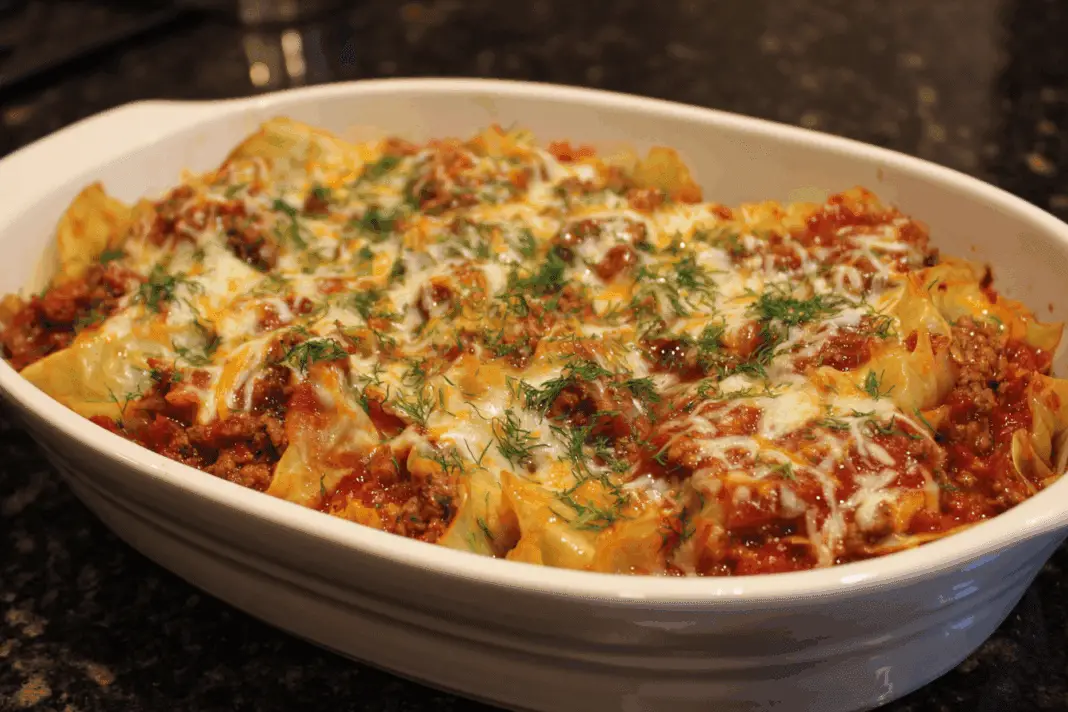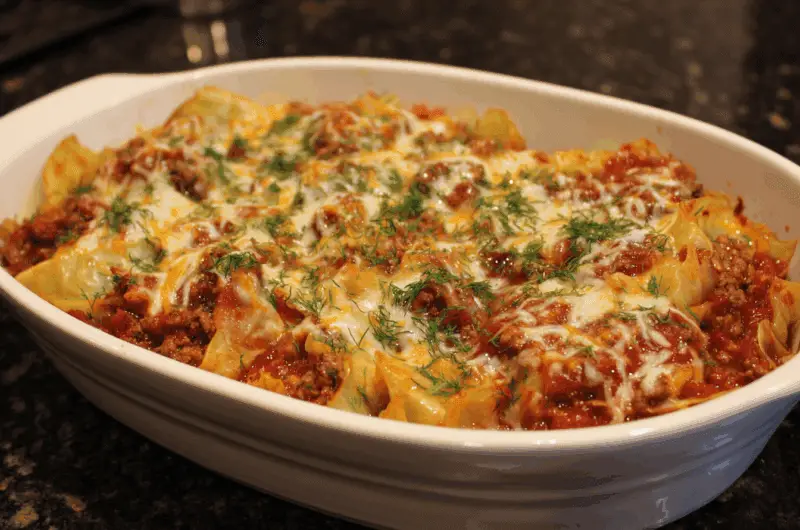Ever stared at a head of cabbage in your fridge, wondering what to do with it besides make coleslaw? This unstuffed cabbage roll casserole might just be the answer to your prayers. Unlike traditional cabbage rolls that require hours of prep time and patience, this version gives you all the comfort food satisfaction in a fraction of the time. Think of it as the lazy person’s version of grandma’s recipe – and honestly, it might just taste better.
Using the wrong meat makes everything bland
Ground beef alone often falls flat in this dish, leaving you with a casserole that tastes like it’s missing something important. The secret lies in mixing your proteins. A combination of ground beef and ground pork creates a richer, more complex base that mimics the traditional stuffed cabbage roll experience. The pork adds fat and depth that beef alone can’t deliver.
If you’re stuck with just ground beef, don’t panic. Add a beef bouillon cube or some Italian sausage to boost the umami factor. Ground turkey works too, but it needs extra seasoning to avoid tasting like cardboard. Some people even throw in bacon bits for extra richness – because bacon makes everything better, right?
Chopping cabbage the wrong size ruins texture
Cabbage pieces that are too small turn into mush, while chunks that are too big stay crunchy and unpleasant. The sweet spot is roughly half-inch pieces – small enough to cook evenly but large enough to maintain some bite. Think about how you’d cut cabbage for a stir-fry, not how you’d shred it for coleslaw.
When prepping your cabbage, remove the tough core and outer leaves first. Roughly chopped cabbage should look like bite-sized pieces that will soften during cooking but still have structure. Pro tip: you can prep this ahead and store it in the fridge for up to a week, making weeknight dinners even easier.
Skipping the rice cooking step creates disaster
Adding raw rice directly to the casserole without understanding liquid ratios leads to either crunchy rice or a watery mess. The rice needs enough liquid to cook properly, but not so much that your casserole becomes soup. Most recipes call for about two cups of liquid (water, broth, or tomato sauce) per cup of rice.
Some versions have you cook the rice separately and stir it in at the end, while others let it cook right in the pot with everything else. One-pot methods work great, but resist the urge to lift the lid during the first 20 minutes of cooking. The steam needs to stay trapped to cook the rice properly.
Wrong tomato products make it too acidic
Using only tomato sauce creates a dish that’s too acidic and one-dimensional. The best versions combine different tomato products for complexity. Diced tomatoes add texture and fresh tomato taste, while tomato sauce provides the base. A tablespoon of tomato paste deepens the overall richness without overwhelming the other ingredients.
If your finished dish tastes too acidic, add a pinch of sugar or a splash of cream to balance things out. Some cooks swear by adding a can of condensed tomato soup for extra sweetness and body. Tomato paste should be cooked with the meat for a minute or two to remove the raw taste before adding other liquids.
Underseasoning makes everything taste flat
Cabbage casseroles need more seasoning than you think. The basic salt and pepper combo doesn’t cut it when you’re dealing with large volumes of mild ingredients like cabbage and rice. Garlic, onion powder, dried dill, and paprika all work well. Don’t forget about bay leaves – they add depth during cooking but remember to remove them before serving.
Fresh herbs make a huge difference if you have them. Parsley, dill, or even a bit of thyme can brighten the whole dish. Creole seasoning adds a nice kick if you like things spicy. Taste as you go and adjust seasonings before the final cooking stage – it’s much harder to fix bland food after everything’s been baked together.
Not layering properly creates uneven cooking
Dumping everything into one pot without thinking about layering leads to uneven cooking and distribution. The heavier ingredients like meat sink to the bottom while lighter ones like cabbage float to the top. This creates hot spots and areas that don’t cook properly. Start with a layer of meat mixture, then cabbage, then repeat.
Some recipes call for pre-cooking the cabbage slightly before layering, which helps it cook more evenly with the other ingredients. Layering properly ensures every bite has the right proportion of meat, vegetables, and rice. End with the meat mixture on top so it browns nicely during baking.
Overcooking turns cabbage into mush
Cabbage goes from perfectly tender to mushy baby food faster than you think. The key is cooking it just until it’s fork-tender but still has some structure. This usually takes about 25-30 minutes in a covered casserole at 350°F. Keep checking after 20 minutes to avoid overcooking.
If you’re using a stovetop method, simmer covered for about 20-30 minutes until the cabbage is tender but not falling apart. Tender cabbage should still have a slight bite to it. Remember that it will continue cooking slightly from residual heat even after you remove it from the stove or oven.
Adding cheese at the wrong time ruins everything
Cheese added too early in the cooking process can become grainy and separate, creating an unappetizing texture. The best time to add cheese is during the last 5-10 minutes of cooking, or right after you remove the dish from heat. The residual heat will melt it perfectly without overcooking.
Shredded cheese works better than chunks because it melts more evenly. Colby Jack, cheddar, or mozzarella all work well. Melted cheese should be gooey and smooth, not separated or grainy. If you’re making this ahead, add the cheese just before reheating to maintain the best texture.
Ignoring leftovers means missing the best part
This casserole actually tastes better the next day after all the ingredients have had time to meld together. The rice absorbs more of the tomato sauce, the cabbage softens to the perfect texture, and all the seasonings marry beautifully. Don’t be surprised if day-two leftovers taste even better than the original meal.
Store leftovers in the fridge for up to four days, or freeze portions for up to three months. Reheating tips include adding a splash of water or broth if it seems dry, and covering with foil to prevent the top from burning. The microwave works fine for individual portions, but the oven gives better results for larger amounts.
This unstuffed cabbage roll casserole proves that shortcuts don’t always mean sacrificing quality. With the right techniques and a little attention to detail, you can create a comforting, satisfying meal that rivals any traditional version. The best part? You’ll have leftovers that taste even better tomorrow.
Ultimate Unstuffed Cabbage Roll Casserole
Cuisine: American6
servings20
minutes35
minutes320
kcalThis deconstructed version of classic cabbage rolls delivers all the comfort food satisfaction with half the work – perfect for busy weeknights when you want something hearty and delicious.
Ingredients
1 pound lean ground beef
8 ounces lean ground pork
1 large onion, diced
3 cloves garlic, minced
1 small head cabbage, chopped into 1/2-inch pieces
1 (14.5-ounce) can diced tomatoes with juice
1 (8-ounce) can tomato sauce
2 tablespoons tomato paste
2 1/2 cups cooked white rice
1 cup shredded Colby Jack cheese
2 teaspoons salt
1 teaspoon black pepper
1 teaspoon dried dill
3 tablespoons fresh parsley, chopped
1 tablespoon olive oil
Directions
- Preheat your oven to 350°F and butter a 9×13-inch casserole dish. This size gives you the perfect depth for even cooking and proper layering. Set the prepared dish aside while you work on the filling.
- Heat olive oil in a large skillet over medium-high heat. Add the ground beef, ground pork, diced onion, and minced garlic to the pan. Cook for 8-10 minutes, breaking up the meat with a wooden spoon until no pink remains and the onions are translucent.
- Drain any excess fat from the meat mixture, then stir in the tomato paste and cook for 1 minute until fragrant. Add the diced tomatoes with their juice, tomato sauce, salt, pepper, dill, and parsley. Bring the mixture to a simmer, then reduce heat to low and cook covered for 10 minutes.
- While the meat sauce simmers, prepare the cabbage by heating a large pan over medium heat. Add the chopped cabbage and cook for 5-7 minutes until it starts to soften but still has some crunch. The cabbage should be tender-crisp, not mushy.
- Remove the meat sauce from heat and stir in the cooked rice, mixing well to combine all ingredients. The rice should be evenly distributed throughout the meat and tomato mixture. Taste and adjust seasoning if needed.
- Layer half of the cooked cabbage in the bottom of your prepared casserole dish. Top with half of the meat and rice mixture, spreading it evenly. Repeat with the remaining cabbage and meat mixture, ending with meat on top for better browning.
- Cover the casserole with foil and bake for 25-30 minutes until heated through and bubbly around the edges. The top should be lightly browned and the casserole should be steaming hot throughout.
- Remove the foil and sprinkle the shredded cheese evenly over the top of the casserole. Return to the oven for 5-7 minutes until the cheese is melted and bubbly. Let rest for 5 minutes before serving to allow the layers to set.
Notes
- This casserole tastes even better the next day as the ingredients have time to meld together. Store leftovers in the fridge for up to 4 days.
- You can substitute ground turkey for the pork, but add a beef bouillon cube for extra richness and depth.
- For a lower-carb version, replace the rice with cauliflower rice and reduce the cooking time slightly.
- This casserole freezes well before or after baking. Thaw overnight in the fridge before reheating.
- If the mixture seems too dry during baking, add a splash of beef broth or water and cover with foil.
Frequently Asked Questions
Q: Can I make this casserole ahead of time?
A: Yes! You can assemble the entire casserole up to 24 hours ahead and refrigerate it before baking. Add about 10-15 minutes to the cooking time if baking straight from the fridge. You can also freeze the assembled casserole for up to 3 months.
Q: What can I substitute for the ground pork?
A: Ground turkey, chicken, or even Italian sausage work well. If using leaner meats like turkey, add a beef bouillon cube for extra richness. You can also use all ground beef, but the pork adds better depth and moisture to the dish.
Q: How do I prevent the rice from getting mushy?
A: Use day-old cooked rice that’s been refrigerated, as it holds its shape better. Don’t overcook the casserole – 25-30 minutes is usually enough. If you’re concerned about texture, you can use parboiled rice which stays firmer during longer cooking times.
Q: Can I use fresh tomatoes instead of canned?
A: Fresh tomatoes work, but they release more water and may make the casserole watery. If using fresh, choose paste tomatoes like Roma, remove excess seeds, and consider adding an extra tablespoon of tomato paste for thickness. Canned tomatoes give more consistent results.


